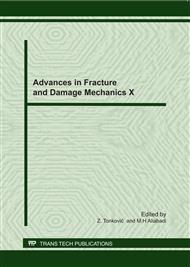p.621
p.626
p.630
p.634
p.638
p.642
p.646
p.650
p.654
Failure Mechanisms and Energy Absorption in Composite Elements under Axial Crush
Abstract:
Test methods are presented to determine failure modes and energy absorption properties of composite crash structural elements from quasi-static tests on chamfered carbon fabric/epoxy tube segment specimens under axial compression loads. High speed film and CT scans of failed specimens are used to identify trigger mechanisms, failure mode evolution at the crush front and failure processes during steady crushing. FE models of failure were developed which could be the basis for materials selection and design procedures for crashworthy composite structures. These are based on meso-scale composites ply damage models combined with cohesive interfaces to represent delamination failures, which damage and fail when the interface fracture energy is reached. The models are implemented in an explicit FE code and parameters for the ply damage and delamination models were obtained from related materials test programmes. The FE models were applied to simulate axial crushing in tube segments and C-channels, showing good predictions of measured peak forces at failure initiation, steady crush forces and total energy absorption.
Info:
Periodical:
Pages:
638-641
Citation:
Online since:
September 2011
Authors:
Price:
Сopyright:
© 2012 Trans Tech Publications Ltd. All Rights Reserved
Share:
Citation:


